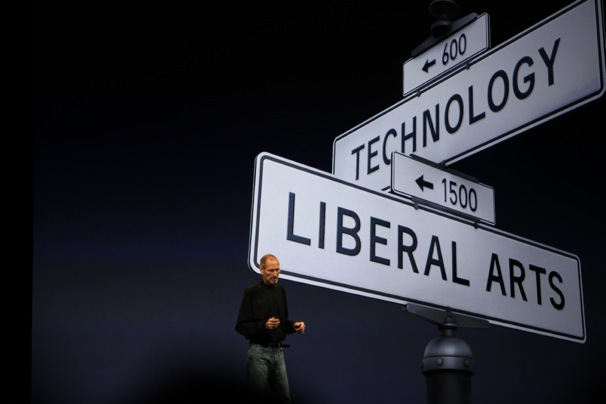Steve Jobs final slide during the unveiling of iPad 2 in 2011 emphasized the theme of his life: A sign showing the corner of Technology Street and Liberal Arts Street.
“It’s in Apple’s DNA that technology alone is not enough. We believe that it is technology married with the humanities that yields us the results that make our hearts sing,” Jobs declared.
His goal, he long maintained, was to stand at the intersection of technology and the humanities.

And as I approach the end of Jobs biography, I realize how true his words were when he said:
“The reason Apple resonates with people is that there’s a deep current of humanity in our innovation. I think great artists and great engineers are similar, in that they both have a desire to express themselves. In fact some of the best people working on the original Mac were poets and musicians on the side. In the seventies computers became a way for people to express their creativity. Great artists like Leonardo Da Vinci and Michelangelo were also great at science. Michelangelo knew a lot about how to quarry stone, not just how to be a sculptor.”
Just seeking to develop a tool to address a need is not enough. The crucial framing of issues by connecting unrelated nuggets of information is essential for innovation. And that is what humanities teach. You learn how to contemplate and frame questions differently. Creative and metaphorical thinking intensifies the analytic process and you get to see and appreciate the protean perspectives of different individuals and groups under new light. After all, seeing things in a new way is what drives innovation.
Moreover, it’s not only about art vis-à-vis science. Rising above this age old dichotomy, we realize that though every discipline, be it research, technology, medicine, marketing, advertising, movie or philosophy have their own ways of dealing with problems, but often the best ideas to make great products come from cutting across disciplinary boundaries.
Continuing with the example of Apple, it is easy to see how it uses the killer combination of hardware, software and services to create great user experience. That too without being the best in any particular technical area. Rivals miss the point when they stress individual features in their products and how they can beat Apple on memory or pixels or battery life. For, more than the individual elements, it’s the overall package that makes the impact. And Apple excels in this very act of putting together a combination of product, software and service such that the combination is more profound than the parts.
Scott Adams, the creator of Dilbert comics, famously shares the same mantra. In his own words:
“It’s unlikely that any average student can develop a world-class skill in one particular area. But it’s easy to learn how to do several different things fairly well. I succeeded as a cartoonist with negligible art talent, some basic writing skills, an ordinary sense of humor and a bit of experience in the business world. The world has plenty of better artists, smarter writers, funnier humorists and more experienced business people. The rare part is that each of those modest skills is collected in one person. That’s how value is created.”
It is in our nature to classify and put in boxes the things which we encounter every day; as we crave for “order” in our minds to get a false sense of empowerment at being able to systematize the chaos around us. Our higher education is the perfect example where students are supposed to specialize in certain fields, while being totally unaware of the opportunities and answers which they can find in others. Best education occurs when students embrace the idea of well-rounded intellectual development taking a good mix of humanities, physical and social science courses.
History confirms that many significant advances in art, business, technology and science have come from cross-fertilization of ideas. Mendel was a philosopher and meteorologist before he founded the science of genetics. Arithmetic and geometry were separate before Descartes, there was no analytic geometry. So were the sciences of electricity and magnetism before Oersted, Faraday and others created the field of electromagnetism. So were astronomy and physics before Kepler borrowed from each to create modern astronomy. The list could go on. The bottom-line being that you never know when and how nuggets of knowledge cutting across disciplines can combine together to transform our future.
Quoting Da Vinci: “To develop a complete mind, study the science of art; study the art of science. Learn how to see. Realize that everything connects to everything else.”